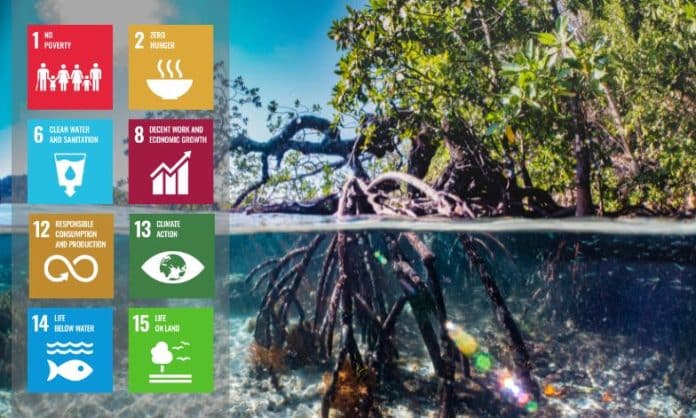While mangrove forests are at risk, whether because of human activities, global warming or water degradation, they are one of the ecosystems capable of contributing to the achievement of several Sustainable Development Goals (SDG).
In total, eight SDGs could be achieved if mangroves were better preserved.
SDG n°1 : No poverty
Mangrove forests provide a sustainable habitat for a multitude of fish and shellfish species. Catching and selling these species is a way to generate income and reduce poverty.
SDG n°2 : Zero Hunger
Mangroves are capable of providing food sources, supporting aquatic habitats and harboring crustacean and fish populations that are important and sustainable sources of protein.
SDG n°6 : Clean water and sanitation
Their roots are able to filter nitrates, phosphates and other pollutants from the water, improving the quality of water flowing from inland to the estuarine environment.
SDG n°8 : Decent work and Economic growth
Across Kenya, an estimated 40 % of the mangroves have been degraded. However, in the Lamu archipelago, conservation organizations and women’s groups have embarked on a project that provides women with loans to open small businesses. They can also receive training in mangrove restoration and conservation.
SDG n°12 : Responsable consumption and production
Sustainable use of mangrove forests would allow for responsible consumption and production. For example, in Malaysia, trees are selectively harvested in 30-year growing cycles and then used to produce charcoal.
SDG n°13 : Climate Action
In this waterlogged environment, leaves and other detritus do not easily decompose. This prevents the carbon contained in this organic matter from escaping as carbon dioxide and is instead trapped and held in the sediment.
SDG n°14 : Life below water
Fish and crustaceans are attracted to mangrove forests because of the wide availability of food, cooler waters and the safety that can be found among the roots.
SDG n°15 : Life on land
The forests are home to a wide variety of biodiversity, including several species of mammals and reptiles and at least 200 species of birds, including threatened species.
More information:

